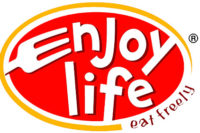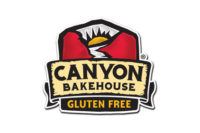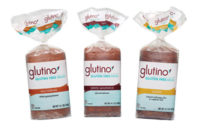Baking treats the gluten-free way



After the cookie dough is mixed, formed and cut into individual pieces, trays of the dough balls are moved to racks and baked.

The baked cookies are then hand-packed into clear recycled plastic trays that are then automatically cartoned.

The production room bakes cookies on a batch basis. Here, baked Chocolate Chip cookies are checked by line operators and are transferred by hand from lined baking trays into the clear recycled plastic carton inserts to keep them stable.

After baked Chocolate Chip cookies are transferred lined baking trays, the are placed in the clear recycled plastic carton inserts to keep them stable.

The clear inserts filled with cookies are automatically wrapped in clear film.

The cookies are then cartoned automatically. An operator looks on to make sure all goes smoothly.








Enjoy Life Foods’ cookies, snack bars, chips, cereals, granolas and trail mixes are made in an allergen-free, gluten-free facility, and the company’s 40,050-sq.-ft. production plant is bulging at the seams to accommodate growing demand for its products. Enjoy Life is expanding at such a rapid pace, it may need to add a facility or relocate to a larger one.
With the increasing number of consumers having what’s now being called “free-from” diet concerns, and food marketers aiming to surge ahead of the gluten-free game, it’s no wonder that Enjoy Life Foods continues to grow. All of its products might be free from soy, gluten and the top eight allergens, but they sure taste good.“Each of our 43 stock-keeping units (SKUs) takes about two years to develop because it has to taste good, and that can be a challenge when you’re baking without conventional ingredients,” explains Joel Warady, the company’s chief sales and marketing officer. Contrary to what many believe, gluten-free is not a fad, he points out. “It’s unlike low-carbs. It’s something people with celiac disease need.”
Running two 10-hour shifts a day, four and a half days a week on four production lines (and contemplating a move to five days and the addition of a third shift), Enjoy Life’s 40,050-sq.-ft. production facility in Schiller Park, Ill., generated 47 million cookies last year, and produced approximately 100,000 lb. of product a week. “Our production is actually greater than that, factoring in another 15% of the products that we assemble instead of bake (like trail mix and cereal),” states plant manager David Kaplan. “And we just get busier all the time.”
Enjoy Life is so busy these days that the company may either have to add another production facility or relocate to a larger one. This is despite the fact that its lentil-based snack chip line, Plentils; baking chocolate; and chocolate bars are copacked offsite.
Growth as a business has been significant for Enjoy Life, observes Scott Mandell, founder and CEO. “We somehow need to increase the size and scope of our facility from an operational standpoint, to allow us to have the capacity to do [more of] what we need to do,” he explains. “In the next couple of years, we see ultimately having a much bigger facility where we can keep up with the demand that we see coming.”
Warady whole-heartedly agrees: “We are really outgrowing this facility. We’re hoping to expand or relocate, but we haven’t made any formal plans.”
Mixing, blending batches
The lively production facility stores the raw ingredients it needs on an immediate basis and keeps others in a satellite warehouse in town. “Everything is brought in and date-coded so that we use it on a first-in/first-out (FIFO) basis,” Warady explains as we tour the mixing area. On the day of SF&WB’s visit, the dedicated production lines were making crunchy Chocolate Chip, Vanilla Honey Graham and Double Chocolate cookies.
“Early on, we created a way to risk-rate suppliers,” Warady adds. “We test all incoming ingredients, some on a more regular basis, depending on the risk-rate. We use both an outside lab for testing and our own in-house lab. We also require documentation to make sure that suppliers are testing their products as well. So we have all sorts of protocols to ensure that we’re not bringing anything into the plant that contains allergens.”
As we head toward the mixing area, we pass racks of just-baked Mini Chocolate Chip cookies, cooling on racks and layered between sheets of reusable silicone-based paper material. Specially trained mixing personnel scoop dry ingredients from bag-lined cases into food-grade mixing bins as three standalone spiral mixers are filled with chocolate chips and wet and dry ingredients. “We create our own flour blends with ancient grains and other flours,” Warady says.
Every bin is labeled. “Even if the different raw ingredients aren’t one of the top eight allergens, everything is labeled so that we know what’s in each bin,” Kaplan notes. “We work on a batch basis for each recipe. Today, we’re making 200-lb. batches of cookies for U.S. and Canadian distribution. Every ingredient added to the mixing bowl is tracked by lot number or code so that we can always have a total recall.”
Because baking is a science and an art, the mixing operators can alter a recipe to accommodate changes in the weather, humidity and varying ingredient formulations. When the cookie dough is ready, the batch of dough is removed from the mixing bowl and transferred to a large tub that’s moved to a custom divider/depositor that sections the cookie dough into balls.
“We use a lot of bulk 275-gallon, steel-reinforced plastic totes to hold ingredients [on the production floor] because they’re spill-resistant,” Warady points out. The totes house liquids, such as brown rice syrup, cane juice, fruit mixes and more, that can be easily dispensed into small containers via a bottom valve.
Maximizing output
Next, the cookie dough is wire-cut into rounded shapes. “This is an older machine, but it just runs and runs,” Warady says, as the thin wire and custom dies create the proper cookie size. “We have two depositors, and sometimes run them at the same time, but we always have to check our oven capacity and look at the whole flow of things to gauge timing of our process.”
The depositor drops the dough balls onto the baking trays. When the trays are full, line operators remove the trays and load them onto baking racks. The dough balls are deposited six-across on the trays, depending on the cookie variety, and yield about 48 cookies per pan. “Most conventional baking racks hold 30 trays, but we had a custom fabricator add 20 more shelves to each rack, so that we increase capacity by 33%,” Kaplan points out.
The racks are then moved to a bank of six rack ovens to bake at 365 deg. F for about 15 min. Baking times and temperatures vary with the product variety. Soft cookies bake at a slightly different temperature, Warady says. “Each product has a different bake time and temperature, and each oven is different from the other ovens,” he explains. “We plan on purchasing two more ovens this year. But if we add ovens and increase our output, we’ll probably have to increase the amount of packaging equipment we’ll need.”
Warady mentions that one of the challenges of baking gluten-free/allergen free products is compensating for the unknown.
While transitioning from one SKU to another, line operators perform an initial test run before baking any more cookies. “This is done to make sure the cookies bake properly,” he says. “We use a standard baking time and temperature, but what’s standard today may not work tomorrow, depending on the ingredients and the humidity. So we make adjustments based on a number of factors.”
After baking, operators move the racks of cookies to cool near a row of large fans. “That’s our ‘high-tech’ cooling system,” Kaplan notes, smiling. “But the fans work well. An exhaust fan blows the hot air out of the facility because the majority of heat in the room comes from the baked cookies themselves.”
No cookie crumbles
Cooling for about 20 minutes, the cookies are then loaded by hand into clear, recycled polyethylene terephthalate (RPET) inner trays. They’re still soft at this point, because they have no preservatives and sometimes stick together, so Enjoy Life developed a clear plastic tray to protect them. Incorporating 12 to 14 cells for each cookie, the trays prevent the cookies from cracking, crumbling or sticking during their six-month shelf life.
The clear trays are then placed on pans that are carried over to an automatic flowrapper that applies a fin-seal barrier film wrap to about 60 trays/min. A second flowrapper that can operate at speeds up to 125 packs/min. is on order, as the company expects to obtain the two new ovens.
Meanwhile, the wrapped trays quickly progress downline and out of the room, on a belt conveyor leading to the packaging area. Once inside the next room, they make a 90-degree turn to one of three magazine-fed cartoners that enclose the trays. Each cartoner is dedicated to a type of product: cookies; bars; and cereals and related products. A line operator also checks each tray of cookies as it’s cartoned and rejects a tray into a bin if something’s amiss.
Next, the cookie-filled cartons are date- and lot-coded by an ink-jet unit before passing through a metal detector and a checkweigher. “If a cookie is missing, the whole carton is underweight,” Warady states. “We have several checks and balances.”
The cartons (package graphics are printed in English and French Canadian for product destined for Canada) are then packed by hand in six-count corrugated shipping cases preprinted with the large oval Enjoy Life logo, the company’s “Eat Freely” slogan and best-by codes and are sent through a semi-automatic tape sealer.
Operators then build a pallet load, which is also labeled with a pressure-sensitive label incorporating production information, product and flavor descriptions and a bar code that can be scanned by a truck or a hand-held scanner. (All case label data is input into a computer on the packaging room floor.) The load is then forklifted to an automatic orbital stretch wrapper, which tightly secures the cases in stretch film, and moved again to the finished goods warehouse.
The packaging area also features, among other equipment, a vertical form/fill/seal line with a gas-flushing system for bags of cereal and packs of trail mix.
Approximately 40% of the shipments go primarily to distributors or are shipped to stores directly, while 60% of Enjoy Life’s customers pick up their shipments at the plant. “We have a seven-day leadtime,” says Kaplan. “The cookies you see today (the soft Chocolate Chip cookies) are out the door and on their way to a distributor within two weeks.”
The company also retains samples of every lot for 18 months, so that if a consumer or a customer ever has a question or suffers an allergic reaction, the lot samples can be pulled and tested. “We test things both in-house and via a third-party lab, so that we can check into anything,” Warady explains. “Our in-house testing lab checks all incoming ingredients and does periodic testing throughout the year. We update all of our manuals and calibrate our metal detectors every hour. We are also audited regularly by Silliker (our last score was 98.6), and we’ll start working with the Safe Quality Food process by January 2015. All of this really keeps our processes moving forward and increases our product quality and safety.”
Food safety-ready
And speaking of quality, a Quality Assurance employee is on the production floor at all times, Warady says. “We also follow the full Hazard Analysis Critical Control Point (HACCP) protocol and have metal detectors and our ovens as control points. Also we conduct regular environmental monitoring for pathogens.”
In terms of food safety and the Food Safety Modernization Act (FMSA), Enjoy Life always goes several steps ahead of requirements. “We’re ready at any time for an inspection by any regulating body,” Warady says. “We document everything, are regularly audited, perform mock recalls throughout the year and every day we assume that an audit could take place.”
In its 12-year history, the company hasn’t had a product recall because it deals with allergens very carefully.
Adds CEO Mandell: “There were no standards for an allergen-free facility when we started out, so we had to set a standard and self-police to ensure our products were made correctly. We continue to have a lot of our original standards in place today.”
Equipment and facility cleaning take place at the end of every week. When processing equipment is not in use, operators cover it until it’s ready to be used again, so no dust or other particles can fall on it, Warady says. “We’re very concerned with cross contamination. We also try to buy equipment that’s made in the U.S.”
Food waste is handled in a couple of ways. “If it’s inedible, we throw it out, but if it makes sense to use it, we do,” he adds. “We also donate some things to food pantries and employees can take some home as well, but hopefully, we don’t have much waste.
“We try to use up all existing materials first and evaluate the best choice in ingredients, like palm oil,” says Warady. “We only buy sustainable palm oil, and make sure suppliers are meeting world standard requirements.”
No shortcuts
The free-from sector is a challenging business, but Enjoy Life makes it look easy. Mandell suggests the following to anyone who wants to start a gluten-free/allergy-free product line: “There are no shortcuts,” he says emphatically. “You have to be cognizant of some very serious matters, be organized and care for the consumers you bake for.”
Looking for a reprint of this article?
From high-res PDFs to custom plaques, order your copy today!













